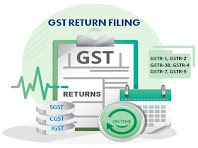GST Returns
What is GST ?
The goods and services tax (GST) is a
value-added tax levied on most goods and services sold for domestic
consumption. The GST is paid by consumers, but it is remitted
to the government by the businesses selling the goods and services. GST provides revenue for the government. It is a destination based tax
Types of GST Returns
GSTR-1 is
the return to be furnished for reporting details of all outward supplies of
goods and services made, or in other words, sales transactions made during a
tax period, and also for reporting debit and credit notes issued. Any
amendments to sales invoices made, even pertaining to previous tax periods,
should be reported in the GSTR-1 return.
GSTR-1 is
to be filed by all normal taxpayers who are registered under GST. It is to be
filed monthly, except in the case of small taxpayers with turnover up to Rs.1.5
crore in the previous financial year, who can file the same on a quarterly
basis.
2. GSTR-2A
GSTR-2A is
the return containing details of all inward supplies of goods and services i.e.
purchases made from registered suppliers during a tax period. The data is
auto-populated based on data filed by the suppliers in their GSTR-1 return.
GSTR-2A is a read-only return and no action can be taken.
3. GSTR-2
GSTR-2 is
the return for reporting the inward supplies of goods and services i.e. the
purchases made during a tax period. The details in the GSTR-2 return are
auto-populated from the GSTR-2A. Unlike GSTR-2A, the GSTR-2 return can be
edited.
GSTR-2 is
to be filed by all normal taxpayers registered under GST, however, the filing
of the same has been suspended ever since the inception of GST.
4. GSTR-3
GSTR-3 is
a monthly summary return for furnishing summarized details of all outward
supplies made, inward supplies received and input tax credit claimed, along
with details of the tax liability and taxes paid. This return is auto-generated
on the basis of the GSTR-1 and GSTR-2 returns filed.
GSTR-3 is
to be filed by all normal taxpayers registered under GST, however, the filing
of the same has been suspended ever since the inception of GST.
5. GSTR-3B
GSTR-3B is
a monthly self-declaration to be filed, for furnishing summarized details of
all outward supplies made, input tax credit claimed, tax liability ascertained and
taxes paid.
GSTR-3B
is to be filed by all normal taxpayers registered under GST.
6. GSTR-4 / CMP-08
GSTR-4 is the return that was to be filed by
taxpayers who have opted for the Composition Scheme under GST. CMP-08 is
the return which has replaced the now erstwhile GSTR-4. The Composition Scheme
is a scheme in which taxpayers with turnover up to Rs.1.5 crores can opt into
and pay taxes at a fixed rate on the turnover declared.
The
CMP-08 return is to be filed on a quarterly basis.
7. GSTR-5
GSTR-5 is
the return to be filed by non-resident foreign taxpayers, who are registered under
GST and carry out business transactions in India. The return contains details
of all outward supplies made, inward supplies received, credit/debit notes, tax
liability and taxes paid.
The
GSTR-5 return is to be filed monthly for each month that the taxpayer is
registered under GST in India.
8. GSTR-6
GSTR-6 is a monthly return to be filed by an Input
Service Distributor (ISD). It will contain details of input tax credit received
and distributed by the ISD. It will further contain details of all documents
issued for the distribution of input credit and the manner of distribution.
9. GSTR-7
GSTR-7 is a monthly return to be filed by persons
required to deduct TDS (Tax deducted at source) under GST. GSTR 7 will contain
details of TDS deducted, the TDS liability payable and paid and TDS refund
claimed, if any.
10. GSTR-8
GSTR-8 is a monthly return to be filed by e-commerce
operators registered under the GST who are required to collect tax at source
(TCS). GSTR-8 will contain details of all supplies made through the E-commerce
platform, and the TCS collected on the same.
The
GSTR-8 return is to be filed on a monthly basis.
11. GSTR-9
GSTR-9 is the annual return to be filed by taxpayers
registered under GST. It will contain details of all outward supplies made,
inward supplies received during the relevant previous year under different tax
heads i.e. CGST, SGST & IGST and HSN codes, along with details of taxes
payable and paid. It is a consolidation of all the monthly or quarterly returns
(GSTR-1, GSTR-2A, GSTR-3B) filed during that year.
GSTR-9 is
required to be filed by all taxpayers registered under GST*, except taxpayers
who have opted for the Composition Scheme, Casual Taxable Persons, Input
Service Distributors, Non-resident Taxable Persons and persons paying TDS under section 51 of CGST Act.
.
12. GSTR-9A
GSTR-9A is
the annual return to be filed by taxpayers who have registered under the
Composition Scheme in a financial year*. It is a consolidation of all the
quarterly returns filed during that financial year.
13. GSTR-9C
GSTR-9C is the reconciliation statement to be filed
by all taxpayers registered under GST whose turnover exceeds Rs.2 crore in a
financial year. The registered person has to get their books of accounts
audited by a Chartered/Cost Accountant. The statement of reconciliation is
between these audited financial statements of the taxpayer and the annual
return GSTR-9 that has been filed.
GSTR-9C is
to be filed for every GSTIN, hence,
one PAN can have multiple GSTR-9C forms being filed.
14. GSTR-10
GSTR-10 is to be filed by a taxable person whose
registered has been cancelled or surrendered. This return is also called a
final return and has to be filed within 3 months from the date of cancellation
or cancellation order, whichever is earlier.
15. GSTR-11
GSTR-11 is the return to be filed by persons who have
been issued a Unique Identity Number(UIN) in order to get a refund under GST
for the goods and services purchased by them in India. UIN is a classification
made for foreign diplomatic missions and embassies not liable to tax in India,
for the purpose of getting a refund of taxes. GSTR-11 will contain details of
inward supplies received and refund claimed.
Due Dates of Filing GST Returns
These returns are as per the CGST
Act*
Return Form
|
Particulars
|
Frequency
|
Due Date
|
GSTR-1
|
Details of outward
supplies of taxable goods and/or services affected
|
Monthly
|
10th* of the next
month
|
GSTR-2
Suspended
|
Details
of inward supplies of taxable goods and/or services affected claiming the
input tax credit.
|
Monthly
|
15th
of the next month
|
GSTR-3
Suspended
|
Monthly
return on the basis of finalization of details of outward supplies and inward
supplies along with the payment of tax.
|
Monthly
|
20th
of the next month
|
GSTR-3B
|
Simple
Return in which summary of outward supplies along with Input Tax Credit
is declared and payment of tax is affected by taxpayer
|
Monthly
|
20th
of the next month
|
CMP-08
|
Return
for a taxpayer registered under the composition levy
|
Quarterly
|
18th
of the month succeeding quarter
|
GSTR-5
|
Return
for a Non-Resident foreign taxable person
|
Monthly
|
20th
of the next month
|
GSTR-6
|
Return
for an Input Service Distributor
|
Monthly
|
13th
of the next month
|
GSTR-7
|
Return
for authorities deducting tax at source.
|
Monthly
|
10th
of the next month
|
GSTR-8
|
Details
of supplies effected through e-commerce operator and the amount of tax
collected
|
Monthly
|
10th
of the next month
|
GSTR-9
|
Annual
Return for a Normal Taxpayer
|
Annually
|
31st
December of next financial year*
|
GSTR-9A
|
Annual
Return a taxpayer registered under the composition levy anytime during
the year
|
Annually
|
31st
December of next financial year*
|
GSTR-10
|
Final
Return
|
Once,
when GST Registration is cancelled or surrendered
|
Within
three months of the date of cancellation or date of cancellation order,
whichever is later.
|
GSTR-11
|
Details
of inward supplies to be furnished by a person having UIN and claiming a
refund
|
Monthly
|
28th
of the month following the month for which statement is filed
|
* Subject
to changes by Notifications/ Orders .
**Statement of self-assessed tax by composition dealers – same as the erstwhile form GSTR-4, which is now made an annual return with effect from FY 2019-2020 onwards.
**Statement of self-assessed tax by composition dealers – same as the erstwhile form GSTR-4, which is now made an annual return with effect from FY 2019-2020 onwards.
Late filing of GST Returns
Return
filing is mandatory under GST. Even if there is no transaction, you must file a
Nil return.
§ You cannot file a return if you
do not file previous month/quarter’s return.
§ Hence, late filing of GST return
will have a cascading effect leading to heavy fines and penalty.
§ The late filing fee of the GSTR-1
is populated in the liability ledger of GSTR-3B filed immediately after such
delay.
Interest/late fees to be paid
§ Interest is 18% per annum. It has
to be calculated by the taxpayer on the amount of outstanding tax to be paid.
It shall be calculated on the Net tax liability identified in the ledger at the
time of payment. The time period will be from the next day of filing due date
till the actual date of payment.
§ As per GST Act Late fee is
Rs. 100 per day per Act. So it is 100 under CGST & 100 under SGST. Total
will be Rs. 200/day. The maximum is Rs. 5,000. There is no late fee on
IGST.
As on 20/04/2020
Reference from GST portal ,ICAI
Study material



